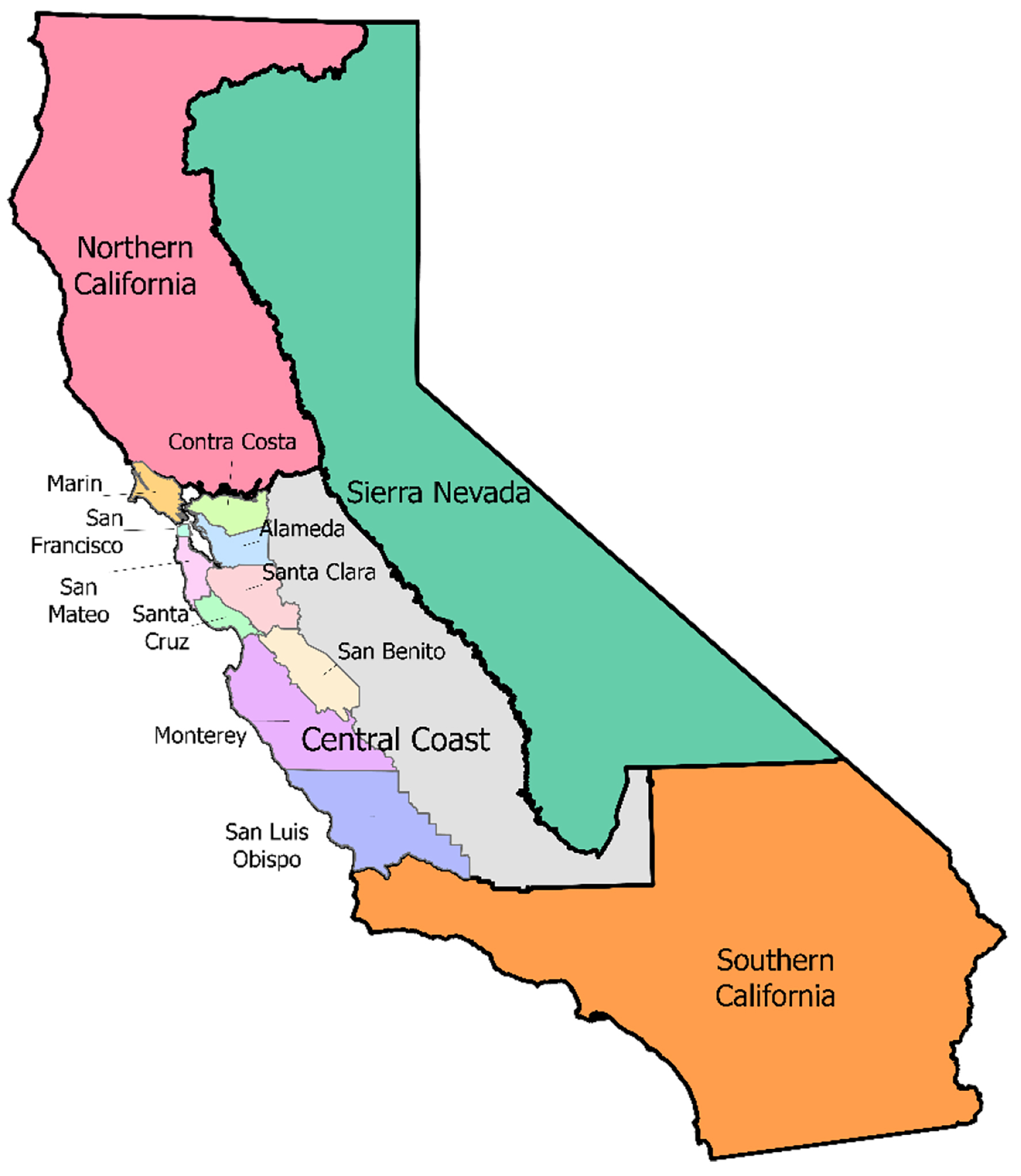Central CoastRegional Profile
The Central Coast Region
The Central Coast Region includes 10 counties that are home to over 7.7 million people. Nearly 90% of this population live within the densely populated San Francisco Bay Area, whereas populations in the southern Central Coast counties (Santa Cruz, San Benito, Monterey, and San Luis Obispo) are spread over a relatively undeveloped landscape known for agriculture and tourism. The Central Coast region has a long history of conservation which is reflected today in the extensive open space and agricultural land that has been preserved. However, managing this land and its rich biological resources is made increasingly challenging by climate change, as well as development pressures associated with regional population growth.
The Central Coast is a mosaic of diverse land types; oak woodlands, mixed conifer forests, coastal chaparral, and herbaceous grasslands exist in close proximity and provide important ecosystem services. This diversity evolved under both natural and human influences. For example, coastal fog creates microclimates that can support significantly different plant and animal communities across relatively small areas. Coastal influences on temperature and moisture also buffer vegetation from the higher summer temperatures and drought experienced inland, enabling the persistence of iconic species such as coast redwood. The Central Coast landscape is also heavily shaped by indigenous land stewardship. For example, centuries of cultural burning cultivated some oak woodlands and coastal prairies that we see today. That historical stewardship was disrupted by European settlement, but there are now increasing efforts to restore native ecosystems by incorporating Traditional Ecological Knowledge into land management.
The complexity of the Central Coast landscape also complicates efforts to manage it. For example, different ecosystems evolved to have different responses to fire. Some native plants, such as bishop pine and Morro manzanita, depend on high-intensity, stand-replacing fire for seed germination but also require long fire-free periods for stands to mature. In contrast, many species of California oak trees and native grasses have evolved to withstand frequent, low-intensity fire that kills competing species. Land managers must be aware of these different adaptations and plan treatments that increase ecological resilience to fire across diverse habitats.
Furthermore, climate change, invasive species, novel pathogens, and human-caused ignitions are interacting to create environmental conditions that are different from what was historically experienced. Similar to other regions of California, the Central Coast is projected to experience warming temperatures and longer dry periods in the future. A longer dry season could increase fire frequency and severity and expanding the wildland-urban interface to provide additional housing makes it more likely that fire will impact human communities.
Efforts to increase ecological and community resilience to wildfire and climate change will require reestablishing Indigenous stewardship practices alongside new approaches that are tailored to modern challenges. It will also require greater capacity to conduct landscape-scale stewardship by collaborating across property boundaries. Numerous partnerships and other initiatives across the Central Coast region are already increasing this capacity. A few examples of current collaborations, such as the Central Coast Prescribed Burn Association, Marin Wildfire Prevention Authority, One Tam, and Santa Cruz Mountains Stewardship Network, are highlighted in this profile [see ‘Resilient and Fire-Adapted Communities’ and ‘Water Security’].
Many programs take a holistic approach to manage fire risk and consider strategies that can offer multiple co-benefits. However, some of these actions have tradeoffs. For example, many exotic species have invaded or even type changed native habitat, changing the fire dynamics of the ecosystem and creating hazardous conditions for nearby communities. Removing invasive plants can increase wildfire resilience, but it might be detrimental to the animal species that use these plants for habitat, such as the migratory monarch butterflies that roost in eucalyptus trees. Understanding the costs and benefits associated with different actions can enable land managers and decision-makers to better reconcile these tradeoffs and gain public support to ultimately increase resilience across the region.

